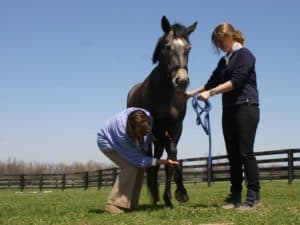Banamine IM Injections: More Than a Pain in the Neck
- Topics: Article, Colic, First Aid, Medications
If you have horses, you’ve probably at one time or another found yourself in the following situation. You arrive at the barn to feed for the evening and your gelding, who is usually a chow-hound, doesn’t come up for dinner. After you bring him up to the barn, you notice that he’s been rolling, and he paws and looks at his sides. Concerned by these signs of colic, you call your veterinarian, but she’s on another call and won’t arrive for at least an hour. His continued signs of pain worry you, and you remember that there is a bottle of Banamine in the tack room medicine cabinet. You want to give this effective pain reliever to your horse, but don’t feel confident about giving intravenous injections, and know that missing the vein can have very serious side effects. You remember hearing that Banamine can be given by the intramuscular (IM) route, and the label on the bottle indicates that this is an approved route. Moreover, you feel comfortable giving an IM injection, as you have seen hundreds of these shots given, and you and your veterinarian have discussed how best to administer IM injections. You wipe the top if the bottle with an alcohol swab, draw up 10 mL of Banamine using a sterile syringe and needle, and head for your horse’s neck, ready to give the injection.
Now it is time to STOP: DON’T GIVE THAT BANAMINE SHOT IM!
Why Not Inject?
IM injections in horses are fairly easy to administer, and many horse owners find this route convenient, especially when a veterinarian is not available to give an intravenous shot. Vaccines, hyaluronic acid products, some antibiotics, sedatives, vitamins, antihistamines, and some anti-inflammatory drugs are labeled for IM use in the horse
Create a free account with TheHorse.com to view this content.
TheHorse.com is home to thousands of free articles about horse health care. In order to access some of our exclusive free content, you must be signed into TheHorse.com.
Start your free account today!
Already have an account?
and continue reading.
Written by:
Tracy E. Norman, VMD, Dipl. ACVIM
Related Articles
Stay on top of the most recent Horse Health news with












